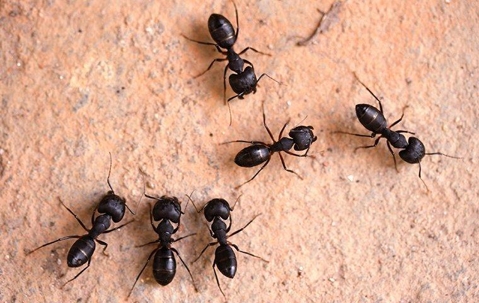Wood is a versatile material. When introduced to fire, it can be used to keep people warm. When processed using the right machinery, it can be turned into paper for notebooks, books, and journals. It can even be used by carpenter ants to build a cozy home. As nice as this can sound, it can become a nightmare if the wood they choose happens to be inside your home. Want to know if your home is at risk? Here is a quick way you can tell if your Dallas home has a carpenter ant problem.
What Are Carpenter Ants?
One of the most obvious signs of a carpenter ant problem is seeing live carpenter ants around your home. How can you tell if the ants you are seeing are carpenter ants? For one, they will seem much larger than your typical home-invading ants. Carpenter ants are the largest native species of ant here in America, measuring at upwards of 18 mm long. That isn’t even counting the queens which can grow to 20 mm in length. As for color, a carpenter ant’s head, thorax, and abdomen are typically a combination of black and red. When doing day-to-day tasks around your home, keep your eye out for these pests wandering around where they don’t belong.
How Destructive Are Carpenter Ants?
Carpenter ants are not as destructive as their close cousins, termites. This does not, however, make the damage they do to homes any less frustrating for homeowners. A nest of carpenter ants can hollow out and seriously damage structural wood in a home and even potentially compromise its safety, given enough time. If not spotted early, this damage could cost you tens of thousands of dollars to fix.
How To Spot Carpenter Ants Inside Your Home
When it comes to wood-destroying pests, early identification is key. To do this, regularly inspect your home for the following signs.
- Frass (fine sawdust) on floors or the ground next to walls or clung to them around tiny pin-sized holes
- Galleries of tunnels running through structural wood around your home
- Hollow-sounding wood
- Soft crinkling coming from inside your walls, sometimes heard best at night
Along with these signs, we recommend regularly checking wood around your property such as trees, stumps, and woodpiles for signs of carpenter ants. Although this may not be a direct sign of carpenter ant problems in your home, it does show that your home could be at risk.
Do Carpenter Ants Eat Wood?
Unlike termites, carpenter ants do not eat the wood they tunnel through. This drives them to forage for sustenance outside the home they build for themselves. Often, this pushes them into homes where they can climb over counter tops, kitchen tables, and through pantries looking for a bite to eat. When found, carpenter ants can be followed which might lead you to where they may be causing damage to your home.
How To Deal With A Carpenter Ant Infestation
Do you suspect your home might have a carpenter ant problem? We have a quick and effective way you can fight back. At Dynasty Pest Control, we provide detailed services for any type or size of carpenter ant infestation. Looking for a way to stop carpenter ants before they ever become an issue for your home? We also offer year-round treatments designed to eliminate carpenter ants on your property before they can damage your home.
Give us a call today to schedule an inspection or treatments for your Dallas home. Our team of qualified technicians is standing by and ready to help you find freedom from pests.

